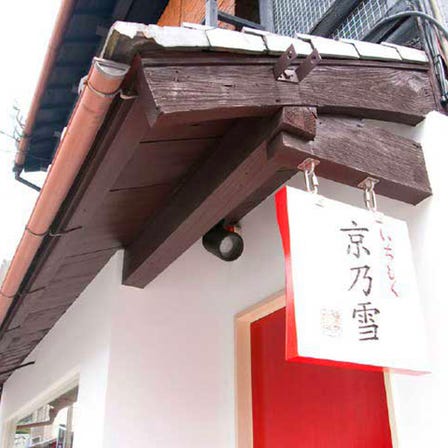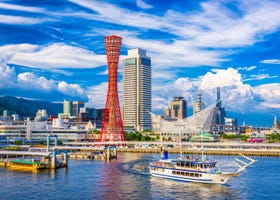Description
Kitano Tenman-gu Shrine is the head shrine of all the Tenman-gu shrines in Japan, and enshrines Sugawara no Michizane. Affectionally known as ”Kitano no Tenjin-san (Mr. Tenjin of Kitano),” its deity is worshipped as a god of learning. The shrine has a close connection with the Toyotomi family; its luxuriant main hall is of Momoyama architecture built by Hideyori Toyotomi in 1607. The honden (the main hall) and the haiden (a hall of worship) are connected by a low building called an ”Ishinoma.” This type of structure is known as ”Yatsumune-zukuri” and has been designated as a National Treasure owing to its importance as a structural remnant passing down the history of shrine architecture. On the 25th of every month, which is the birth and death anniversary day of Sugawara no Michizane, the Tenjin Market is held where the grounds liven up with lots of stalls crowded with people. The shrine is also famous as a popular viewing spot for plum blossoms and colorful maple leaves.
A plethora of cultural assets—including National Treasures—await in the treasure hall
Built in 1927, the treasure hall is home to a large number of art works or offerings such as ancient documents, swords, gold and silver lacquer works, folding screens, and tea utensils. Its collection includes the Kitano Tenjin Engi scroll painting (Jokyu-bon: Painted in the Jokyu period, early thirteenth century) (National Treasure), a painting of Kitano Oochano-yu (The Great Kitano Tea Gathering), the legendary tachi (long sword) Onikirimaru (otherwise known as Higekiri) (Important Cultural Property), and the tachi Kunihiro (Important Cultural Property) that was donated by Hideyori Toyotomi. Special-themed exhibitions are held each season along with the permanent collection on display year-round.
View varieties of plum blossoms at Kyoto's premier viewing spot
The shrine's grounds play host to 1,500 plum trees representing about 50 species, known for their Sugawara no Michizane connections. From early February to late March its plum garden is open to the public, making it a must if you're in Kyoto at the time. While you're there, visit a tea house to sample some green tea and Japanese confectionery. On February 25, which is the death anniversary of Sugawara no Michizane, the Baikasai (plum blossom festival) is held in a solemn atmosphere. Within the shrine grounds, the enormous outdoor tea ceremony is simultaneously held, where you can enjoy viewing plum blossoms together with tea and confectionery served by geisha (Japanese traditional female entertainer) and maiko (geisha apprentice) from Kamishichiken (the oldest geisha district in northwest Kyoto).
Beautiful autumn maple trees at the Momiji-en on Hideyoshi's Odoi designated as national historical sites
The western part of the shrine's grounds holds the remnants of Odoi, earthen fortification mounds built by Hideyoshi Toyotomi to protect Kyoto's urban area from flood waters. They have been designated as national historical sites. Surviving with a wealth of nature including a nearly 400 year-old tree, these historical remains have become the Momiji-en (autumn maple garden) where you can see around 350 maple trees. The garden is open to the public from late October to early December and illuminated at night from early November.
Location Information
-
- Address
-
Bakurocho, Kamigyo-ku, Kyoto-shi, Kyoto, 602-8386
-
- Nearest Station
-
Kitanohakubaicho Station
・ Keifuku Dentetsu-kitano Line
5 minutes on foot
-
- Phone Number
-
075-461-0005Available languagesonly in Japanese
-
- Hours
-
5:00am - 6:00pm
*From April to September
5:30am - 5:30pm
*From October to March
-
- Closed
- None
-
- Public Site
- Official Site
Recommended Spots in Area
- Visiting
- Eating
- Shopping
- Lodgings
-
 Ryoan-ji TempleArashiyama, UzumasaTemples
Ryoan-ji TempleArashiyama, UzumasaTemples -
 Ninna-ji TempleArashiyama, UzumasaTemples
Ninna-ji TempleArashiyama, UzumasaTemples -
 Nishijin Textile CenterNijo Castle, Kyoto Imperial PalaceFabrics
Nishijin Textile CenterNijo Castle, Kyoto Imperial PalaceFabrics -
 Imamiya Jinja ShrineKinkakuji Temple, KitayamaShrines
Imamiya Jinja ShrineKinkakuji Temple, KitayamaShrines -
 Hirano Jinja ShrineKinkakuji Temple, KitayamaShrines
Hirano Jinja ShrineKinkakuji Temple, KitayamaShrines -
 Former Imperial Villa Nijo-jo CastleNijo Castle, Kyoto Imperial PalaceCastles
Former Imperial Villa Nijo-jo CastleNijo Castle, Kyoto Imperial PalaceCastles
-
Moxy Kyoto (Marriott Group)Nijo Castle, Kyoto Imperial PalaceHotels
-
Kyoto Brighton HotelNijo Castle, Kyoto Imperial PalaceHotels
-
NenrinboKinkakuji Temple, KitayamaRyokan
-
Yadoya NishinokyoNijo Castle, Kyoto Imperial PalaceApartments/Serviced Apartments
-
MoganaNijo Castle, Kyoto Imperial PalaceHotels
-
La'gent Hotel Kyoto NijoNijo Castle, Kyoto Imperial PalaceEconomy Hotels







































